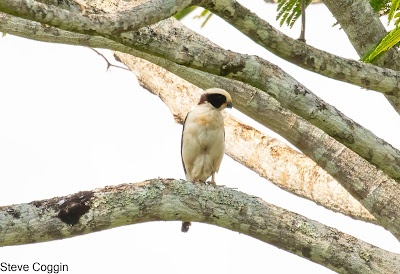 |
| White-necked Jacobin (Florisuga mellivora). Rio Bravo Conservation Area, Belize. |
Belize is a small country on the Caribbean coast of Central America. It is a mere two-and-a-half-hour plane ride from Atlanta but despite its proximity, it is a world apart from our daily experience. Belize has tropical forests, savannas and mangrove-fringed islands atop the second longest barrier reef in the world. We recently traveled there with a group of North Carolina birders to experience what the tropics had to offer. This blog will deal with the first of the three locations we visited.
Our first stop was the Rio Bravo Conservation Area in northwestern Belize, near the border with Mexico and Guatemala. This wild area is a large block of conserved land that connects reserves in all three countries. The Conservation Area butts up against the extensive fields and pastures of the Mennonite farmers of Belize. The Bio Bravo Conservation Area is managed by Project for Belize and has pine savanna, tropical broad-leaf forest, rivers and lagoons. Our group stayed at the La Milpa Field Station near the Mayan archeological site of the same name.
Hummingbirds abounded near the Field Station and in the surrounding forest. The large Green-breasted Mango (Anthracothorax prevostii) fed on wild flowers while White-necked Jacobins (Florisuga mellivora) buzzed around the hummingbird feeders that ringed the outdoor dining room at the Station. Tiny Wedge-tailed Sabrewings (Campylopterus pampa) feed on the orange-flowered Flamboyant tree (Delonix regia).
 |
| Green-breasted Mango (Anthracothorax prevostii). Rio Bravo Conservation Area, Belize. |
 |
| White-necked Jacobin. Rio Bravo Conservation Area, Belize. |
 |
| Wedge-tailed Sabrewing (Campylopterus pampa). Rio Bravo Conservation Area, Belize. |
Four species of large birds were also around the Field Station. Male Great Curassows (Crax rubra) were dueling for supremacy on the lawns while Ocellated Turkeys (Meleagris ocellata) strolled the grounds with chicks. Crested Guans (Penelope purpurascens) perched in tall trees watching this show while a large flock of Plain Chachalacas (Ortalis vetula) jabbered from the undergrowth.
 |
| Great Curassows (Crax rubra). Rio Bravo Conservation Area, Belize. |
 |
| Crested Guan (Penelope purpurascens). Rio Bravo Conservation Area, Belize. |
 |
| Ocellated Turkey (Meleagris ocellata). Rio Bravo Conservation Area, Belize. |
 |
| Ocellated Turkey. Rio Bravo Conservation Area, Belize. |
 |
| Plain Chachalaca (Ortalis vetula). Rio Bravo Conservation Area, Belize. |
Raptors were abundant in the area. The most impressive was a flyover by a King Vulture (Sarcoramphus papa). This bird is the third largest vulture in the New World, behind only the California Condor (Gymnogyps californianus) and Andean Condor (Vultur gryphus). Roadside Hawks (Rupornis magnirostris) were common on savannas and around farms, hunting from perches, often on the side of the road. We saw many Laughing Falcons (Herpetotheres cachinnans) perched in trees, carefully watching for their favorite prey, snakes. One evening we went in search of owls and we hit the jackpot. A Barn Owl (Tyto alba) was giving its high-pitched scream while a Mottled Owl (Ciccaba virgata) and two Black-and-white Owls (Strix nigrolineata) perched nearby.
 |
| King Vulture (Sarcoramhpus papa). Rio Bravo Conservation Area, Belize. |
 |
| Roadside Hawk (Rupornis magnirostris). Rio Bravo Conservation Area, Belize. |
 |
| Laughing Falcon (Herpetotheres cachinnans). Rio Bravo Conservation Area, Belize. |
 |
| Black-and-white Owl (Strix nigrolineata). Rio Bravo Conservation Area, Belize. |
The neotropics has many species of flycatchers and we found quite a few. The largest and most conspicuous was the Great Kiskadee (Pitangus sulphuratus). With its rufous wings, yellow breast and belly, and striped head, this flycatcher always stood out. Social Flycatchers (Myiozetetes similis) have a similar color pattern but are smaller. A pair of Social Flycatchers had a dome-shaped nest with an entry hole made of fine fibers and we watched them make regular visits to feed their young. Couch's Kingbirds (Tyrannus couchii) and Tropical Kingbirds (Tyrannus melancholicus) are very similar in appearance and are best distinguished by their vocalization. We saw both species around the Field Station. Yellow-bellied Elaenias (Elaenia flavogaster) also nested near the Station. They had the yellow belly, as advertised, and a jaunty crest.
 |
| Great Kiskadee (Pitangus sulphuratus). Rio Bravo Conservation Area, Belize. |
 |
| Social Flycatcher (Myiozetetes similis). Rio Bravo Conservation Area, Belize. |
 |
| Social Flycatcher nest. Rio Bravo Conservation Area, Belize. |
 |
| Couch's Kingbird (Tyrannus couchii). Rio Bravo Conservation Area, Belize. |
 |
| Lesson's Motmot (Motmotus lessonii). Rio Bravo Conservation Area, Belize. |
 |
| American Pygmy Kingfisher (Chloroceryle aenea). Rio Bravo Conservation Area, Belize. |
 |
| Gartered Trogon (Trogon caligatus). Rio Bravo Conservation Area, Belize. |
 |
| Masked Tityra (Tityra semifasicata). Rio Bravo Conservation Area, Belize. |
 |
| Collared Aracari (Pteroglossus torquatus). Rio Bravo Conservation Area, Belize. |
The forest had many birds that crawled along tree trunks. The beautiful Chestnut-colored Woodpecker (Celeus castaneus) has a dark brown body, a blond, crested head and males have red on the face. The American tropics are the home to many species of woodcreepers including the large Ivory-billed Woodcreeper (Xiphorhynchus flavigaster) and the diminutive Olivaceous Woodcreeper (Sittasomus griseicapillus).
 |
| Chestnut-colored Woodpecker (Celeus castaneus). Rio Bravo Conservation Area, Belize. |
 |
| Ivory-billed Woodcreeper (Xiphorhyncus flavigaster). Rio Bravo Conservation Area, Belize. |
 |
| Red-capped Manikin (Ceratopipra mentalis). Rio Bravo Conservation Area, Belize. |
This excellent trip was organized by the Mecklenburg Audubon
Society through Natural Selections Tours.
Our guides, Roni Martinez and Abimael Moralez, worked tirelessly from
dawn to late in the night. They made sure everyone
in the group got to see and hear the terrific birds of Belize. Roni and Abi were not just bird guides. They
knew the plants, mammals, reptiles, insects, history and more about
their country. Our final total was 191
bird species and I saw 21 life birds but many of our group saw many more. Thanks
to all who went on the trip and to all who made it so enjoyable.



Great story; amazing photos
ReplyDeleteThanks Sheila.
ReplyDelete